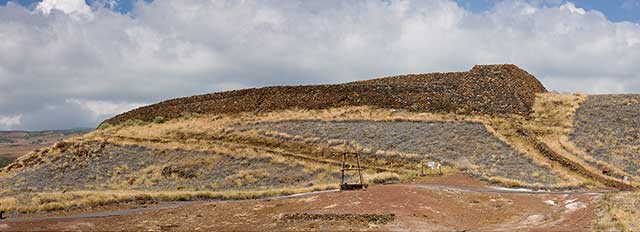Pu'ukoholā Heiau National Historic Site
The Temple on the Hill of the Whale

The stone heiau at Pu'ukoholā is one of the last major sacred structures built in Hawaii before outside influences altered traditional life permanently. Constructed in 1790-91 by Kamehameha I, this heiau, or temple, played a crucial role in the ruler's ascendancy. By 1790, Kamehameha, whom many believed destined to rule all of the Hawaiian islands, had invaded and conquered Maui, Lāna'i, and Moloka'i. Yet he was not able to lay full claim to his home island of Hawai'i because of opposition from his chief rival and cousin, Keō Kūahu'ula. While on Moloka'i, Kamehameha learned Keōua was invading his territory. Kamehameha sent his aunt to seek direction from the prophet Kāpoūkahi, who told her that Kamehameha would conquer all the islands if he built a large heiau dedicated to his family war god Kūkā'ilimoku (Kū) atop Pu'ukoholā—Whale Hill—at Kawaihae.
Kamehameha set to work immediately. According to the prophecy, the builders had to follow rigid guidelines in order to please Kū the war god. To ensure perfection, the prophet Kāpoūkahi served as the royal architect. Thousands of men camped out on the hills for nearly a year to work on the massive structure. Because the heiau had to be constructed of water-worn lava rocks, it is believe that rocks came from the seaside valley of Pololū. Workers formed a human chain at least 20 miles long and transported the rocks hand to hand to the top of Pu'ukoholā. Kamehameha himself labored with the others. When news of the war temple reached the rival chiefs, they decided they must attack while Kamehameha and his warriors were occupied. At the least, the rivals would interfere with the ritually specified construction process, and Kū would be displeased. At best, the invasion would eliminate Kamehameha dn the threat he posed to his rivals. The chiefs of Maui, Lāna'i, and Moloka'i reconquered their islands and, joined by the chiefs of Kaua'i and O'ahu, sailed to attack Kamehameha. Kamehameha counterattacked, routed the invaders, and resumed work.
In the summer of 1791 the heiau was finished. Kamehameha invited his cousin Keōua Kūahu'ula to the dedication ceremonies. Perhaps awed by the power of the heiau and its god, perhaps resigned to the ascendancy of his cousin, Keōua Kūahu'ula came willing to what would be his doom. When he arrived there was a scuffle and, whether Kamehameha intended it or not, Keōua and almost all of his companions were slain. The body of Keōua was carried to the heiau and offered as the principal sacrifice to Kū.
The death of Keōua Kūahu'ula ended all opposition on the island of Hawai'i, and the prophecy began to come true. By 1810, through conquest and treaties, Kamehameha the Great, builder of Pu'ukoholā Heiau, was the revered king of all the Hawaiian Islands.